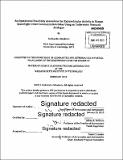| dc.contributor.advisor | Jeffrey A. Hoffman. | en_US |
| dc.contributor.author | Stanković, Aleksandra, S.M. Massachusetts Institute of Technology | en_US |
| dc.contributor.other | Massachusetts Institute of Technology. Department of Aeronautics and Astronautics. | en_US |
| dc.date.accessioned | 2015-06-10T19:14:06Z | |
| dc.date.available | 2015-06-10T19:14:06Z | |
| dc.date.copyright | 2015 | en_US |
| dc.date.issued | 2015 | en_US |
| dc.identifier.uri | http://hdl.handle.net/1721.1/97365 | |
| dc.description | Thesis: S.M., Massachusetts Institute of Technology, Department of Aeronautics and Astronautics, 2015. | en_US |
| dc.description | Cataloged from PDF version of thesis. | en_US |
| dc.description | Includes bibliographical references (pages 45-52). | en_US |
| dc.description.abstract | As manned space exploration advances beyond low-Earth orbit, new challenges in the planning and execution of mission tasks such as extravehicular activity (EVA) will emerge. One such challenge will be the mitigation of risks associated with communication delay between Earth and remote exploration crews. This paper provides an introduction to the problem of EVA operations under Mars-like communication delay, and evaluates the feasibility of a relay-based communication protocol through a research investigation conducted at an underwater space flight analogue facility. Three underwater dive expeditions were completed to investigate the impact of communication time delay on the execution of a model geological survey EVA. To simulate communication with an exploration team on Mars or a near-Mars asteroid, a 5-minute transmission delay was instituted each way between divers and mission controllers. Performance measures tracked included task completion times, number of sampling activities completed, and incidence of task interruptions which delayed sampling activities. Findings indicate that, even under communication delay, aquanauts were able to complete a high number of the prescribed mission tasks, with only minimal interruptive events occurring. Task complexity was a major determining factor for completion duration, and the occurrence of interruptive events did not significantly increase completion times. Overall, the findings from this study support the operational feasibility of a relay-based strategy for mitigating risks related to communication delay. While further work remains to be done, this study represents an initial step in the elucidation of an important operational consideration for the success of future manned missions beyond Earth orbit. | en_US |
| dc.description.statementofresponsibility | by Aleksandra Stankovic. | en_US |
| dc.format.extent | 53 pages | en_US |
| dc.language.iso | eng | en_US |
| dc.publisher | Massachusetts Institute of Technology | en_US |
| dc.rights | M.I.T. theses are protected by copyright. They may be viewed from this source for any purpose, but reproduction or distribution in any format is prohibited without written permission. See provided URL for inquiries about permission. | en_US |
| dc.rights.uri | http://dspace.mit.edu/handle/1721.1/7582 | en_US |
| dc.subject | Aeronautics and Astronautics. | en_US |
| dc.title | An operational feasibility assessment for extravehicular activity in human spaceflight under communication delay using an underwater research analogue | en_US |
| dc.type | Thesis | en_US |
| dc.description.degree | S.M. | en_US |
| dc.contributor.department | Massachusetts Institute of Technology. Department of Aeronautics and Astronautics | |
| dc.identifier.oclc | 910664895 | en_US |
